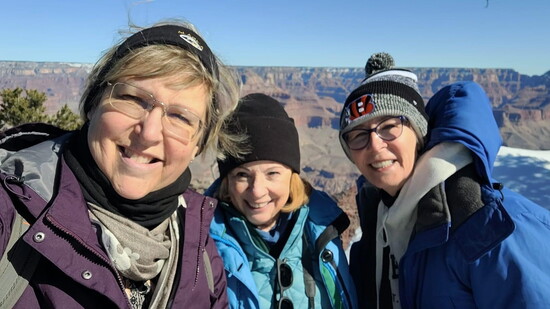There’s nothing like staggering statistics to make people aware of how prevalent an issue is or how much we need to discuss a topic. Statistics from AARP cite that an estimated (and staggering) 75% of married women will become widows. Yet beyond the statistics are real people (mothers, sisters, friends, co-workers, neighbors and perhaps you) who’ve navigated the journey through death and grief. And while that process can include pain and sadness, there can also be bonding, laughter, lessons, love and new lives. These many facets of widowhood are captured in the timely new book, “Widows Among Us: Stories and Insights,” by Karen S. Justice, MBA, Karen R. Smith-Racicot, CLC, and Rebecca K. LaChance, PhD.
While these three amazing, resilient, funny and empathetic women had different paths to widowhood (ranging from sudden death to a three-year journey), they wrote a book that connects with those experiencing various types of losses, captivates audiences with their stories, helps readers process or prepare for loss and provides strategies for anyone supporting a grieving person. The book’s title emerged from Deuteronomy 16:11 in the Bible, which speaks of rejoicing with the widows among us. When the three authors gathered to discuss their book, they held back tears, shared laughter and beautifully reflected the stories, insights and practical advice chronicled throughout its pages.
As “Widows Among Us” states: “Today, widowhood is still a sensitive and frequently neglected subject. This book aims to bring this important topic into the spotlight by highlighting and addressing its unique and often disregarded aspects.” The book, both inspirational and educational, is an easy read and a perfect gift. Rather than restating its contents, what follows are a few questions posed to the authors, providing additional insight into their experiences and their work.
What's been the hardest part of your journey as a widow?
Reflecting on her three-year journey from her husband’s pancreatic cancer diagnosis to his passing, Karen Justice spoke of managing multiple emotions while trying to be strong for her partner. At times, she was overwhelmed with the pain of knowing she was going to be a widow. Because she and her husband, John, didn’t have biological children together, she now sees herself as an “orphaned elder,” another difficult aspect of widowhood for her.
Karen Smith-Racicot spoke of having to redefine herself, work through past trauma and become a new person. Trauma was also a theme for Dr. Rebecca LaChance, who recalled going into an existential crisis. She noted, “I literally had a dark night of the soul, and I realized that Frank's death and my coming out of it was really a spiritual reckoning. I had to do some in-depth work about childhood trauma.”
What’s one good thing (perhaps something you learned, a skill or relationship you developed) that has happened as a result of your journey?
Karen Smith-Racicot noted that her loss “just catapulted me out of my comfort zone, and from that has come a new life. I've remarried, I've got two wonderful stepkids and seven grandkids. I love the life that I have right now. I really do, but it's very different from the life I would have had with Sam.” While it has taken time and trials, each woman has rebuilt her life. They all spoke of the joy they have in their current lives (especially their ability to travel and the bond they now share). Yet they try to be intentional about not feeling guilty for experiencing such happiness. They acknowledged that it was okay to love and miss their deceased spouses while simultaneously enjoying their new lives.
Why should people read this book?
The women wholeheartedly agreed that they’ve written a “feel-good book” full of hope and resilience. They acknowledge that parts are sad and may evoke emotions, but readers have noted cathartic responses to the authors’ stories. Both men and women have said they could not put the book down.
The authors take pride in the book’s beauty, including the beauty of its message. Dr. Rebecca LaChance spoke of the kintsugi pot as a metaphor for the book. “The Japanese philosophy of kintsugi is that when something is broken, you repair it with precious metals so that it’s still usable again and beautiful. The philosophy of kintsugi is the philosophy of life: we get broken, but we can honor that brokenness and put it back together in beauty and function.”
According to Karen Smith-Racicot, “this book is for everybody. It is not just for widows. It is three stories of hope and resilience.” She also notes that “it talks about being prepared beforehand, which is super important.”
Before the conversation ended, Karen Justice noted: “Our stories are very different, and yet through each of them, there is enough commonality. We continue to make the point that no widow's grief is like another widow's grief. So many factors influence the relationship, her personality, the circumstances, etc., that we try to emphasize that no one should judge someone on how they grieve. That's one of our key takeaways.”
She closed by sharing one of her favorite sayings, “life is lived forward, but it’s understood backward.” “Widows Among Us” allows the authors to look back and share what they now understand about life as they “live forward,” moving from grief to growth.
Widows Among Us can be found locally at Curious Iguana, Barnes & Noble and online at Amazon. ThreeWidows.com
Dr. Denise Rollins
Whole Heart Grief & Life Resource Center Executive Director
Denise helps people navigate grief from life, death and differences via coaching, consulting and classes on conflict, communication, connection and culture. Her education, experience and empathy help create a world where individuals and organizations transform grief into growth.
